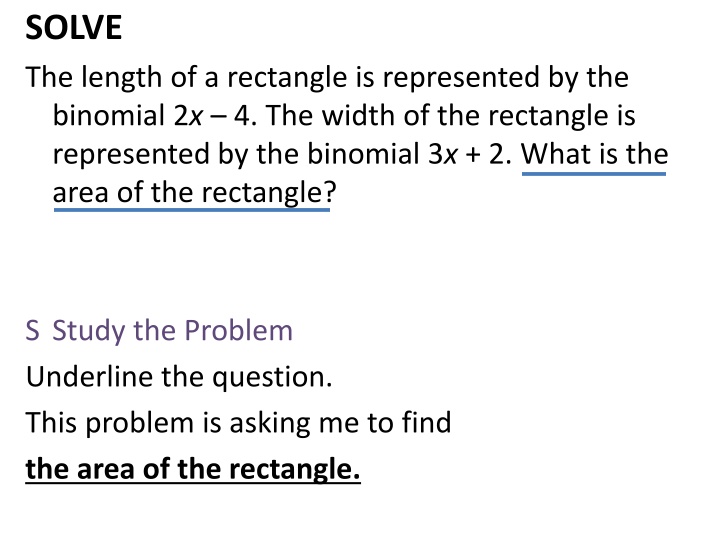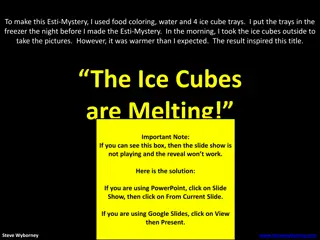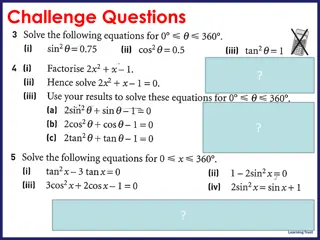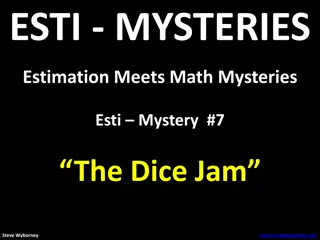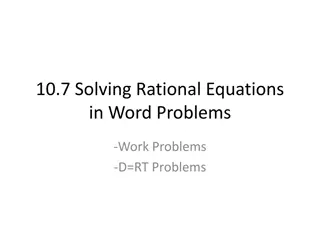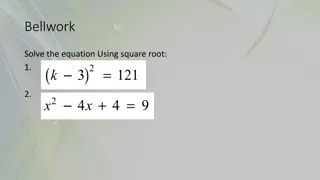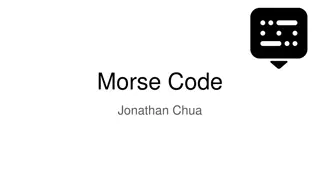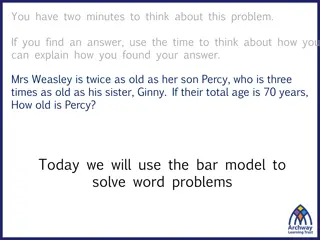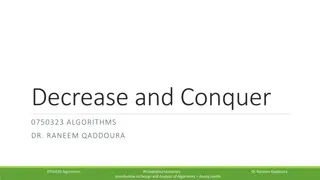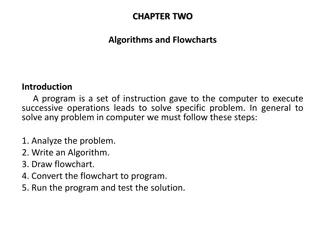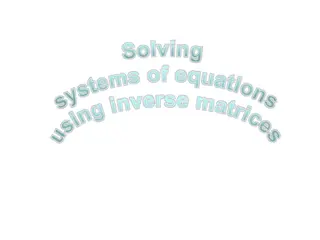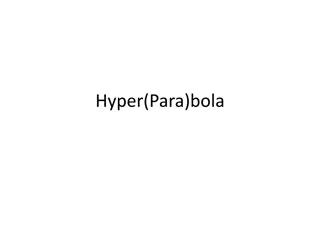SOLVE
The problem involves calculating the area of a rectangle using binomial expressions for its length and width. By multiplying the binomials representing the length and width, you can find the area of the rectangle. The steps to solve the problem are detailed with helpful visuals.
Download Presentation

Please find below an Image/Link to download the presentation.
The content on the website is provided AS IS for your information and personal use only. It may not be sold, licensed, or shared on other websites without obtaining consent from the author.If you encounter any issues during the download, it is possible that the publisher has removed the file from their server.
You are allowed to download the files provided on this website for personal or commercial use, subject to the condition that they are used lawfully. All files are the property of their respective owners.
The content on the website is provided AS IS for your information and personal use only. It may not be sold, licensed, or shared on other websites without obtaining consent from the author.
E N D
Presentation Transcript
SOLVE The length of a rectangle is represented by the binomial 2x 4. The width of the rectangle is represented by the binomial 3x + 2. What is the area of the rectangle? S Study the Problem Underline the question. This problem is asking me to find the area of the rectangle.
Multiplying Binomials Problem 1: (x+1)(x+2) The first factor will be represented vertically with a yellow x tile and a small yellow square. The second factor will be represented horizontally with a yellow x tile and 2 small yellow squares. We can find the product of these binomials by finding the area that they create with a length of (x + 1) and a width of (x + 2).
Multiply a Monomial by a Binomial Problem 1: (x+1)(x+2) x times x gives us a product of x2 x times 1 gives us a product of x x times 1 gives us a product of x OR x times 2 gives us a product of 2x
Multiply a Monomial by a Binomial Problem 1: (x+1)(x+2) 1 times x gives us a product of x 1 times 1 gives us a product of 1 1 times 1 gives us a product of 1 OR 1 times 2 gives us a product of 2 The product is 1 yellow x2 tile, 3 yellow x tiles, and 2 small yellow squares or x2 + 3x + 2.
Box Method Problem 1: (x+1)(x+2) List each term of the first binomial vertically on each row of the box. x +2 x List each term of the second binomial horizontally on each column of the box. +1 Then, we can multiply until every box has a product!
Box Method Problem 1: (x+1)(x+2) x times x gives us a product of x2 x +2 x times +2 gives us a product of +2x x2 +2x x +1 times x gives us a product of +x +1 +x +2 +1 times +2 gives us a product of +2 x2 + 2x + x + 2 x2 + 3x + 2 2x and x are like terms, so we can combine them for a total of 3x. Our answer is x2 + 3x + 2.
Multiplying Binomials Problem 2: (x+2)(x+1) The first factor will be represented vertically with a yellow x tile and 2 small yellow squares. The second factor will be represented horizontally with a yellow x tile and a small yellow square. We can find the product of these binomials by finding the area that they create with a length of (x + 2) and a width of (x + 1).
Multiplying Binomials Problem 2: (x+2)(x+1) x times x gives us a product of x2 x times 1 gives us a product of x 1 times x gives us a product of x 1 times 1 gives us a product of 1
Multiplying Binomials Problem 2: (x+2)(x+1) 1 times x gives us a product of x 1 times 1 gives us a product of 1 The product is 1 yellow x2 tile, 3 yellow x tiles, and 2 small yellow squares or x2 + 3x + 2.
Box Method Problem 2: (x+2)(x+1) List each term of the first binomial vertically on each row of the box. x +1 x List each term of the second binomial horizontally on each column of the box. +2 Then, we can multiply until every box has a product!
Box Method Problem 2: (x+2)(x+1) x times x gives us a product of x2 x +1 x times +1 gives us a product of +x x2 +x x +2 times x gives us a product of +2x +2 +2x +2 +2 times +1 gives us a product of +2 x2 + x + 2x + 2 x2 + 3x + 2 x and 2x are like terms, so we can combine them for a total of 3x. Our answer is x2 + 3x + 2.
Multiplying Binomials What do you notice about the answers to Problems 1 and 2? They have the same answer! What holds true? The commutative property holds true when multiplying polynomials.
Multiplying Binomials Problem 1: (x+3)(x+2) The first factor will be represented vertically with a yellow x tile and 3 small yellow squares. The second factor will be represented horizontally with a yellow x tile and 2 small yellow squares. We can find the product of these binomials by finding the area that they create with a length of (x + 3) and a width of (x + 2).
Multiply a Monomial by a Binomial Problem 1: (x+3)(x+2) x times x gives us a product of x2 x times 1 gives us a product of x x times 1 gives us a product of x
Multiply a Monomial by a Binomial Problem 1: (x+3)(x+2) 1 times x gives us a product of x 1 times 1 gives us a product of 1 1 times 1 gives us a product of 1
Multiply a Monomial by a Binomial Problem 1: (x+3)(x+2) 1 times x gives us a product of x 1 times 1 gives us a product of 1 1 times 1 gives us a product of 1
Multiply a Monomial by a Binomial Problem 1: (x+3)(x+2) 1 times x gives us a product of x 1 times 1 gives us a product of 1 1 times 1 gives us a product of 1 The product is 1 yellow x2 tile, 5 yellow x tiles, and 6 small yellow squares or x2 + 5x + 6.
Box Method Problem 1: (x+3)(x+2) List each term of the first binomial vertically on each row of the box. x +2 x List each term of the second binomial horizontally on each column of the box. +3 Then, we can multiply until every box has a product!
Box Method Problem 1: (x+3)(x+2) x times x gives us a product of x2 x +2 x times +2 gives us a product of +2x x2 +2x x +3 times x gives us a product of +3x +3 +3x +6 +3 times +2 gives us a product of +6 x2 + 2x + 3x + 6 x2 + 5x + 6 2x and 3x are like terms, so we can combine them for a total of 5x. Our answer is x2 + 5x + 6.
Multiplying Binomials Problem 2: (x 1)(2x+4) The first factor will be represented vertically with a yellow x tile and a small red square. The second factor will be represented horizontally with 2 yellow x tiles and 4 small yellow squares. We can find the product of these binomials by finding the area that they create with a length of (x 1) and a width of (2x + 4).
Multiplying Binomials x times x gives us a product of x2 x times x gives us a product of x2 Problem 2: (x 1)(2x+4) x times 1 gives us a product of x x times 1 gives us a product of x x times 1 gives us a product of x x times 1 gives us a product of x
Multiplying Binomials 1 times x gives us a product of x Problem 2: (x 1)(2x+4) 1 times x gives us a product of x 1 times 1 gives us a product of 1 1 times 1 gives us a product of 1 1 times 1 gives us a product of 1 1 times 1 gives us a product of 1
Multiplying Binomials Problem 2: (x 1)(2x+4) The product is 2 yellow x2 tiles, 4 yellow x tiles, 2 red x tiles and 4 small red squares. Our x tiles are not all in one color so we must take away zero pairs. Now, our answer is 2x2 + 2x 4.
Box Method Problem 1: (x 1)(2x+4) List each term of the first binomial vertically on each row of the box. 2x +4 x List each term of the second binomial horizontally on each column of the box. 1 Then, we can multiply until every box has a product!
Box Method Problem 1: (x 1)(2x+4) x times 2x gives us a product of 2x2 2x +4 x times +4 gives us a product of +4x 2x2 +4x x 1 times 2x gives us a product of 2x 1 2x 4 1 times +4 gives us a product of 4 2x2 + 4x 2x 4 2x2 + 2x 4 4x and 2x are like terms, so we can combine them for a total of 2x. Our answer is 2x2 + 2x 4.
Multiplying Binomials Problem 3: (x+3)(x 2) The first factor will be represented vertically with a yellow x tile and 3 small yellow squares. The second factor will be represented horizontally with a yellow x tile and 2 small red squares. We can find the product of these binomials by finding the area that they create with a length of (x + 3) and a width of (x 2).
Multiply a Monomial by a Binomial Problem 3: (x+3)(x 2) x times x gives us a product of x2 x times 1 gives us a product of x x times 1 gives us a product of x
Multiply a Monomial by a Binomial Problem 3: (x+3)(x 2) 1 times x gives us a product of x 1 times 1 gives us a product of 1 1 times 1 gives us a product of 1
Multiply a Monomial by a Binomial Problem 3: (x+3)(x 2) 1 times x gives us a product of x 1 times 1 gives us a product of 1 1 times 1 gives us a product of 1
Multiply a Monomial by a Binomial Problem 3: (x+3)(x 2) 1 times x gives us a product of x 1 times 1 gives us a product of 1 1 times 1 gives us a product of 1
Multiply a Monomial by a Binomial Problem 3: (x+3)(x 2) The product is 1 yellow x2 tile, 3 yellow x tiles, 2 red x tiles and 6 small red squares. Our x tiles are not all in one color so we must take away zero pairs. Now, our answer is x2 + x 6.
Box Method Problem 3: (x+3)(x 2) List each term of the first binomial vertically on each row of the box. x 2 x List each term of the second binomial horizontally on each column of the box. +3 Then, we can multiply until every box has a product!
Box Method Problem 3: (x+3)(x 2) x times x gives us a product of x2 x 2 x times 2 gives us a product of 2x x2 2x x +3 times x gives us a product of +3x +3 +3x 6 +3 times 2 gives us a product of 6 x2 2x + 3x 6 x2 + x 6 2x and 3x are like terms, so we can combine them for a total of x. Our answer is x2 + x 6.
Multiplying Binomials Problem 4: (x 3)(x+1) The first factor will be represented vertically with a yellow x tile and 3 small red squares. The second factor will be represented horizontally with a yellow x tile and 1 small yellow square. We can find the product of these binomials by finding the area that they create with a length of (x 3) and a width of (x + 1).
Multiply a Monomial by a Binomial Problem 4: (x 3)(x+1) x times x gives us a product of x2 x times 1 gives us a product of x 1 times x gives us a product of x 1 times 1 gives us a product of 1
Multiply a Monomial by a Binomial Problem 4: (x 3)(x+1) 1 times x gives us a product of x 1 times 1 gives us a product of 1 1 times x gives us a product of x 1 times 1 gives us a product of 1
Multiply a Monomial by a Binomial Problem 4: (x 3)(x+1) The product is 1 yellow x2 tile, 1 yellow x tile, 3 red x tiles and 3 small red squares. Our x tiles are not all in one color so we must take away zero pairs. Now, our answer is x2 2x 3.
Box Method Problem 4: (x 3)(x+1) List each term of the first binomial vertically on each row of the box. x +1 x List each term of the second binomial horizontally on each column of the box. 3 Then, we can multiply until every box has a product!
Box Method Problem 4: (x 3)(x+1) x times x gives us a product of x2 x +1 x times +1 gives us a product of +x x2 +x x 3 times x gives us a product of 3x 3 3x 3 3 times +1 gives us a product of 3 x2 + x 3x 3 x2 2x 3 x and 3x are like terms, so we can combine them for a total of 2x. Our answer is x2 2x 3.
Multiplying Binomials Problem 5: (2x 1)(x+2) The first factor will be represented vertically with 2 yellow x tiles and a small red square. The second factor will be represented horizontally with a yellow x tile and 2 small yellow squares. We can find the product of these binomials by finding the area that they create with a length of (2x 1) and a width of (x + 2).
Multiplying Binomials Problem 5: (2x 1)(x+2) x times x gives us a product of x2 x times 1 gives us a product of x x times 1 gives us a product of x
Multiplying Binomials Problem 5: (2x 1)(x+2) x times x gives us a product of x2 x times 1 gives us a product of x x times 1 gives us a product of x
Multiplying Binomials Problem 5: (2x 1)(x+2) 1 times x gives us a product of x 1 times 1 gives us a product of 1 1 times 1 gives us a product of 1
Multiplying Binomials Problem 5: (2x 1)(x+2) The product is 2 yellow x2 tiles, 4 yellow x tile, 1 red x tile and 2 small red squares. Our x tiles are not all in one color so we must take away zero pairs. Now, our answer is 2x2 + 3x 2.
Box Method Problem 5: (2x 1)(x+2) List each term of the first binomial vertically on each row of the box. x +2 2x List each term of the second binomial horizontally on each column of the box. 1 Then, we can multiply until every box has a product!
Box Method Problem 5: (2x 1)(x+2) 2x times x gives us a product of 2x2 x +2 2x times +2 gives us a product of +4x 2x2 +4x 2x 1 times x gives us a product of x 1 x 2 1 times +2 gives us a product of 2 2x2 + 4x x 2 2x2 + 3x 2 4x and x are like terms, so we can combine them for a total of 3x. Our answer is 2x2 + 3x 2.
Multiplying Binomials Problem 6: (2x+3)(x 1) The first factor will be represented vertically with 2 yellow x tiles and a small red square. The second factor will be represented horizontally with a yellow x tile and 2 small yellow squares. We can find the product of these binomials by finding the area that they create with a length of (2x + 3) and a width of (x 1).
Multiplying Binomials Problem 6: (2x+3)(x 1) x times x gives us a product of x2 x times 1 gives us a product of x x times x gives us a product of x2 x times 1 gives us a product of x
Multiplying Binomials 1times x gives us a product of x Problem 6: (2x+3)(x 1) 1 times 1 gives us a product of 1 1times x gives us a product of x 1 times 1 gives us a product of 1 1times x gives us a product of x 1 times 1 gives us a product of 1
Multiplying Binomials Problem 6: (2x+3)(x 1) The product is 2 yellow x2 tiles, 3 yellow x tile, 2 red x tiles and 3 small red squares. Our x tiles are not all in one color so we must take away zero pairs. Now, our answer is 2x2 + x 3.
